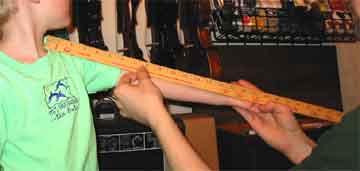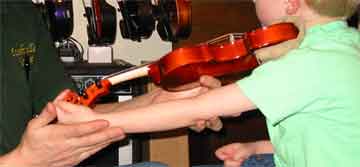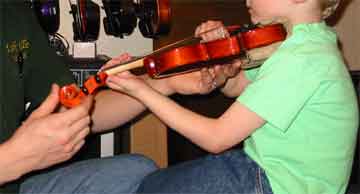the following text and images were copied with permission from Nashville Violin's website...
Violins and violin-family instruments come in smaller sizes to make it easier for children to learn to play. An instrument that is too big can be nearly impossible to play, while one too small may not produce the best tone and technique.
Violins and violin-family instruments come in smaller sizes to make it easier for children to learn to play. An instrument that is too big can be nearly impossible to play, while one too small may not produce the best tone and technique.
 | With the left arm fully extended, palm up, and a yardstick under the chin to simulate a violin, record the measurement in the center of the palm. At this point you don't want any slack in the arm, the measurements below will indicate the correct size of the instrument with a proper bend in the elbow. |
Violin:
Under 14" = 1/32 Size
14" to 15 3/8" = 1/16 Size
15 3/8" to 16 7/8" = 1/10 Size
17" to 18 1/2" = 1/8 Size
18 1/2" to 20 3/8" = 1/4 Size
20 3/8" to 22 1/4" = 1/2 Size
22 1/4" to 23 5/8" = 3/4 Size
Over 23 5/8" = 4/4 (Full Size)
Under 14" = 1/32 Size
14" to 15 3/8" = 1/16 Size
15 3/8" to 16 7/8" = 1/10 Size
17" to 18 1/2" = 1/8 Size
18 1/2" to 20 3/8" = 1/4 Size
20 3/8" to 22 1/4" = 1/2 Size
22 1/4" to 23 5/8" = 3/4 Size
Over 23 5/8" = 4/4 (Full Size)
 | If you have access to a violin already, here's how you can determine if it is the correct size. With the arm fully extended, the child should be able to fold his fingers around the end of the scroll and still have a slight bend in his elbow. |
There are a few other factors to consider when determining the proper size of instrument. It is usually best to get an instrument that is too small than to try and play an instrument that is too big. This is especially true for beginners.

